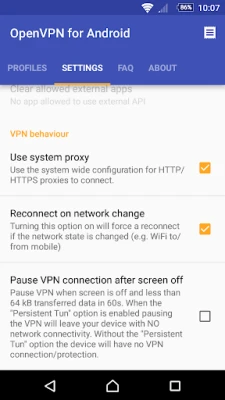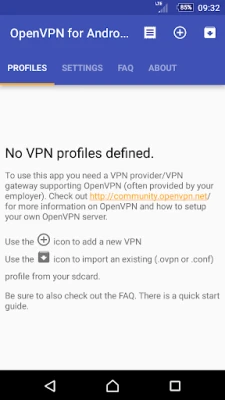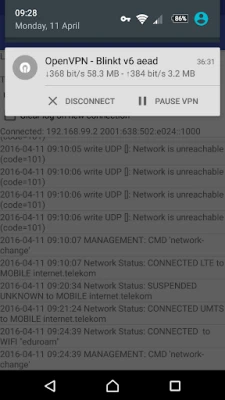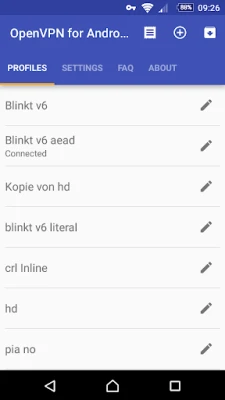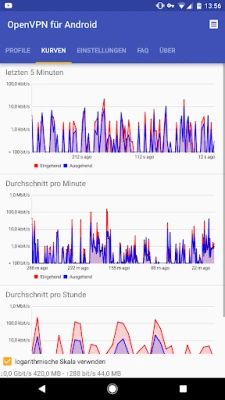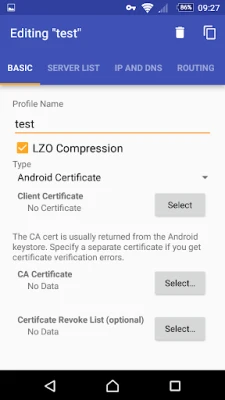
Latest Version
0.7.55
March 19, 2025
Arne Schwabe
Communication
Android
0
Free
de.blinkt.openvpn
Report a Problem
More About OpenVPN for Android
Unlocking the Power of OpenVPN: A Comprehensive Guide
In today's digital age, securing your online presence is more crucial than ever. OpenVPN stands out as a reliable solution for establishing secure connections. This article delves into the functionalities of OpenVPN, its requirements, and how to maximize its potential without compromising your device's integrity.
What is OpenVPN?
OpenVPN is an open-source VPN solution that allows users to connect to a secure server, ensuring privacy and data protection. Unlike other VPN applications, OpenVPN does not sell or provide VPN services directly; instead, it connects users to their own or third-party OpenVPN servers. This flexibility makes it a popular choice among tech-savvy individuals and organizations alike.
Requirements for Using OpenVPN
To utilize OpenVPN, you need a device running Android 4.0 or higher. Importantly, this application does not require any form of jailbreak or root access, making it accessible for a broader audience. Users can easily download and install the OpenVPN client from the Google Play Store, ensuring a straightforward setup process.
Connecting to OpenVPN: A Step-by-Step Guide
Connecting to an OpenVPN server is a simple process. Follow these steps to get started:
- Download the OpenVPN client from the Google Play Store.
- Obtain the OpenVPN configuration files from your server provider or set up your own server.
- Import the configuration files into the OpenVPN app.
- Launch the app and select the server you wish to connect to.
- Click on the connect button and wait for the connection to establish.
Once connected, your internet traffic is encrypted, providing a secure browsing experience.
Understanding OpenVPN Modes: TAP vs. TUN
OpenVPN primarily operates in two modes: TAP and TUN. However, due to Android's limitations, only TUN mode is supported on devices running Android 4.0 and above. TUN mode is a virtual point-to-point connection that routes IP packets, making it suitable for most users. Unfortunately, TAP mode, which supports Ethernet bridging, is not available in this version.
Frequently Asked Questions (FAQ)
Can I Get Free Internet with OpenVPN?
No, OpenVPN is not designed to provide free internet access. It serves as a client to connect to an OpenVPN server, which may be hosted by your organization, university, or a commercial VPN provider.
What Sets OpenVPN Apart from Other VPN Apps?
OpenVPN distinguishes itself by being an open-source platform, allowing users to connect to various servers without being tied to a single provider. For a detailed comparison of different OpenVPN clients available on the Play Store, visit the OpenVPN FAQ page.
How Does OpenVPN Handle Media Access on Older Android Versions?
For devices running Android versions older than 6.0, OpenVPN requires access to your photos and media. This access is necessary for importing OpenVPN profiles from your device's internal memory or SD card.
Joining the OpenVPN Beta Program
The OpenVPN beta program is open for users who wish to test new features before their official release. To join, simply opt into the beta program through the Google Play Store. Keep in mind that beta versions may not always be available, as they are primarily used for pre-testing release candidates.
Contributing to OpenVPN: Translation and Feedback
If you're interested in helping improve OpenVPN, consider contributing by translating the app into your native language. Visit the project's homepage for more information on how to get involved.
Reporting Bugs and Suggestions
Users are encouraged to report any bugs or suggestions via email or through the Google Code project. However, it is advisable to review the FAQ section before reaching out for assistance.
Security Features of OpenVPN
Security is a top priority for OpenVPN. The application utilizes its own version of OpenSSL, which is not vulnerable to the Heartbleed bug. For more details on OpenVPN's security measures and the Heartbleed issue, visit the OpenVPN community page.
Conclusion
OpenVPN is a powerful tool for anyone looking to enhance their online security and privacy. With its user-friendly interface and robust features, it provides a reliable solution for connecting to secure servers without the need for jailbreak or root access. By following the guidelines outlined in this article, you can effectively utilize OpenVPN to safeguard your online activities.
Rate the App
User Reviews
Popular Apps










Editor's Choice











